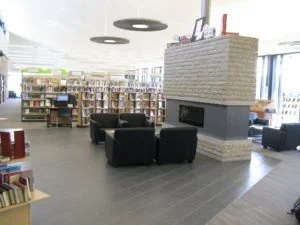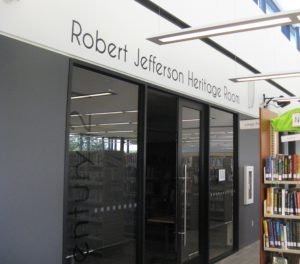SHARE
A New Library, A New Vision
By Bob Turner
Jim and Betty Anne Gaynor donated $ 1.5 million to the construction of a new library on condition that funding from the City of Selkirk, the Rural Municipalities of St. Clements and St. Andrews, and the Province of Manitoba was in place, and that the new library would be built on time, and within budget.
On January 10, 2014, the Gaynor Family Library opened its doors to the public, having been completed on time and under budget.
Meeting these targets had been achieved through a unique concept: a thirteen member citizen-run building committee, comprised of a professional engineer, a professional accountant, a professional property manager, a representative from each of the three municipal councils, board chairs of the planning board and library, and library staff members.
And the library itself is unique in a number of ways: Funding, Atmosphere, Environmental Impact (with inclusion of outdoor space), and Services Offered.
FUNDING
As indicated in the history part of this story, the concept of municipal collaboration was new, and effective in involving citizens of the three municipalities by providing a sense of ownership. Support from people like the Gaynors, people like Robert Jefferson, for whom the Heritage Room is named, and the large number of businesses and individuals who donated money made the new library possible. The donor board in the entry/cafeteria/tutoring/socializing area of the library pays tribute to the major donors.
A $5.6 million facility in a community of our size does not pop up every day in every community. It is a source of pride for the community and the people who helped to make it happen.
The ATMOSPHERE of our library is unlike any library you have previously visited. To quote Director of Library Services, Ken Kuryliw, “It’s not a shushing library”.
While there are dedicated “quiet” zones, such as the Robert Jefferson Heritage Room, the building is a multi-purpose center for the entire community, housing not just the library, but the Red River Planning District offices, meeting spaces for community groups, and a local independent café.
There is a teen area, a colourful and appealing children’s area, and an electric fireplace with a beautiful Tyndall stone hearth, where you will usually find people gathered to read the newspaper, or visit over a coffee on a cool day.
ENVIRONMENTAL IMPACT
Any environmentally-conscious person will be impressed with the extent to which the library is a model of the Three R’s in its construction and operation.
Reduced site waste was achieved through using an existing paved lane from a failed development, thus saving the environment and reducing the cost of replacing it.
Reduced construction costs came about through the reuse of library shelves – some repurposed from the old Main Street library, some Provincial surplus metal shelves, and some from a bankruptcy sale.
Recycled materials were used to an impressive extent: reclaimed woods throughout for the facility and furniture; recycled steel from the local Gerdau Steel mill; composite counters from recycled glass; carpets made from 100% recycled fibres; flooring and ceiling tiles from reclaimed materials.
Reduced environmental impact resulted from local sourcing of raw construction materials from a 100 km radius of the site where possible, (Manitoba Tyndall stone from nearby Gillis Quarries and local reclaimed wood for example). Also, contractors, subcontractors, and professionals were all from within 50 km, reducing the environmental impact of commuting.
The Library is designed and constructed to meet the requirements of Manitoba’s Green Building Policy. Much of the facility is illuminated by natural light coming in through large expanses of south-facing windows, plus more windows on the ceiling. The building and process has been independently verified and recognized as Power Smart and designated with a three Green Globe rating for its numerous green technologies, including a complete geothermal heating and cooling system. All bathroom fixtures are low water use and powered by solar cells to turn on water and flush. Lighting in some areas of the facility is triggered by use, saving energy when the area is unoccupied.
Only green eco certified products are used to clean the facility, no fossil fuels are burned in the building, and low VOC/emitting paints, sealants, and finishes are used.
The library encourages minimizing personal vehicles with a pick-up and drop-off location, pedestrian-only walkways, connected to a bus stop, and bike racks to welcome cyclers. The high efficiency parking lot lighting is controlled by a system which only calls for lighting when required, and it avoids creating a heat island by way of considerable green space.
The facility is 38.7% more efficient than the Model National Energy Code for Buildings.
As Ken Kuryliw ponts out, it is an environmentally-responsible building, constructed within the proposed budget, proving that green buildings, can be budget friendly.
The outdoors also a key part of its design, thanks to a partnership with Eastern Interlake Conservation District whose involvement ultimately led to three of the total five acres dedicated to an urban prairie reserve adjacent to the building. An interpretive trail winds through the site which features more than 50 different local and natural grasses and flowers, showcasing a rare piece of native prairie ecosystem.
Local farmers helped provide the composted biomass for the soil used in this urban prairie, another example of reusing and cooperative community spirit. And this April, we saw this cooperative spirit at work again, as volunteers with Prairie Habitats Inc., (with members of the Selkirk Fire Department on hand), hosted a controlled burn of the area, recreating the ecosystem that would have been present hundreds of years ago, helping to rejuvenate the growth of the now urban prairie.
Landscaping, with what’s called a sedge meadow bioswale or gently sloped shallow drainage course, collects run-off from the surrounding area, parking lot, and building’s roof and is also a teaching tool about water conservation. The drainage course holds run-off in it for as long as possible to remove silt and pollution from surface run-off water.
The library was given special recognition in 2015 by the Manitoba Conservation District Association.
SERVICES …THE NUMBERS TELL THE REAL STORY
“We’ve definitely set a new standard for libraries in Manitoba,” he said.
The Gaynor Family Library is the third busiest in the province, averaging 500 patrons per day using the facilities.
The 18,000 square foot facility has 60,000 books, 20,000 e-books and 4,000 DVDs. In addition, it boasts more than 140 magazine subscriptions, French, Ukrainian, and Indigenous collections, audio books on cd, young adults and children’s sections, more than 4,000 picture books, a large print collection, and some braille content.
Services include free access to the Internet, e-mail, research, or word processing. Special child computers feature an imaginative interface for ages 2-8, with programs that are certified for educational and developmental content.
Those wishing to conduct research may do so by way of Ebscohost, which is an online research database which can access millions of articles In addition, a large number of databases, ranging from NASA to National Geographic are available for users.
Its operating budget is about $750,000, with $155,000 paid by Selkirk, $105,000 by each of the two RMs, while the province chips in about $290,000.
It has redefined what a library can be, and is, as one of its brochures proudly states…
So why not become a bibliotourist, by visiting one of the most attractive places in Red River North – The Gaynor Family Library – one more Red River Reason.
Whatever the season, there’s always a reason to spend time in Red River North!





